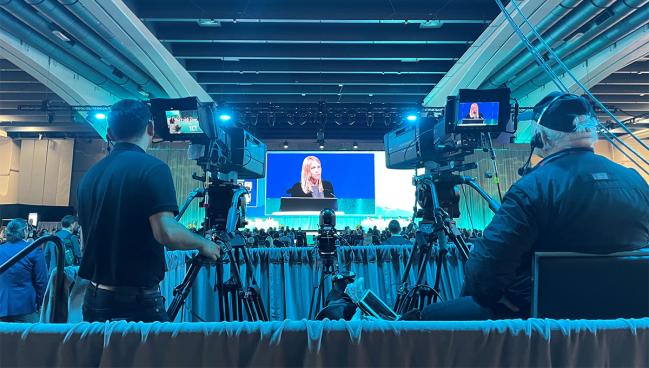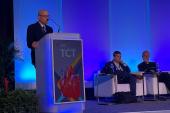TRILUMINATE Deep Dive Clarifies ‘Meaningful’ QoL Gains With Tricuspid TEER
The benefits observed with edge-to-edge repair were greater in patients with worse baseline status.

In patients with severe tricuspid regurgitation (TR), transcatheter edge-to-edge repair (TEER) using the TriClip system (Abbott) substantially improves patient symptoms, functional status, and quality of life (QoL) through 1-year, according to new in-depth data from the TRILUMINATE pivotal trial.
The findings, presented in a late-breaking clinical trials session today at TCT 2023, follow data from the same trial presented earlier in the meeting showing 1-year safety and efficacy of the procedure in additional patients randomized to TEER or medical therapy alone as well as those with complex anatomies treated with TEER.
“The results really do support that tricuspid TEER probably does improve the health status of patients, and I think it's just a matter of trying to find who are the right patients—who are the ones who are symptomatic from their TR who are going to be most likely to benefit—and targeting to those,” Suzanne V. Arnold, MD (Saint Luke’s Mid America Heart Institute and University of Missouri-Kansas City, Kansas City, MO), who presented the findings, told TCTMD.
Suzanne Baron, MD (Massachusetts General Hospital, Boston), who discussed the findings during the session, said, “This study adds to the growing body of literature that transcatheter edge-to-edge repair, either in the mitral or tricuspid position, really does result in significant and clinically meaningful improvement in quality of life for these patients.”
Commenting on the study for TCTMD, Dee Dee Wang, MD (Henry Ford Health System, Detroit, MI), said, “The most important takeaway is that there is clinical benefit.”. However, she added, “we are learning about the right-heart pathophysiology and tricuspid regurgitation as we are doing these clinical trials, and we may not have all the correct endpoints for the right heart.”
Because of this, past studies “may not be truly showing the benefit of transcatheter therapies in the right heart,” Wang continued. “It was great that this is the first study that is looking at KCCQ scores and quality of life. It is really about what patients want. Is their goal to run a marathon or is their goal to basically get up out of a chair and be independent and be able to take care of themselves and be in their own house on their own?”
The study was simultaneously published in the Journal of the American College of Cardiology.
QoL Endpoints
For the study, researchers looked at the first 350 patients with severe TR randomized in TRILUMINATE to tricuspid TEER (n = 175) or medical therapy (n = 175).
At 1 month, patients treated with TEER saw significantly improved health status as assessed by the Kansas City Cardiomyopathy Questionnaire (KCCQ) compared with those on medical therapy alone (mean between-group difference 9.4 points), with a small additional improvement seen at both 6 months (mean between-group difference 11.2 points) and 1 year (mean between-group difference 10.4 points).
Additionally, those in the TEER arm were more likely than those in the medical therapy cohort to be alive and well at 1 year (defined as KCCQ-OS ≥ 60 and no decline from baseline of > 10 points; 74.8% vs 45.9%; P < 0.001), with a number needed-to-treat of 3.5 patients. The benefit of TEER went down with increasing baseline KCCQ-OS (P for interaction < 0.001).
“Patients with worse health status at baseline were the ones most likely to benefit,” Arnold said.
In exploratory analyses of all patients from the TRILUMINATE Pivotal trial, including those enrolled in the trial’s single-arm portion, much of the health status benefit seen with TEER was tied to reductions in TR, with every one-grade improvement in TR seen from baseline to 1 year associated with about a 4.1-point increase in KCCQ. This was also strongly correlated with lower rates of mortality and heart failure hospitalization at 1 year.
“Though we cannot fully exclude responder bias or even the placebo effect, the exploratory analysis suggests that the observed health status improvement is at least partially biologically mediated,” Arnold concluded. “So we think that these results support the use of [tricuspid] TEER for improvement of symptoms, functional limitations, and quality of life.”
‘Substantial’ Improvements
Patient-centered endpoints are powerful in people with TR, who tend “to prioritize quality of life over quantity,” Baron said. “The fact that you found a mean difference in improvement between treatment groups of 10-11 points on the KCCQ overall summary score between TEER and medical therapy is substantial.” For context, she said that empagliflozin (Jardiance, Boehringer Ingelheim/Eli Lilly) and sacubitril/valsartan (Entresto; Novartis) have only been associated with mean differences in the KCCQ score of one to two points and cardiac resynchronization therapy has been associated with about eight-point gains.
“It’s also important to note that on the categorical analysis, over 50% of patients treated with TEER had that 10-point or more improvement translating to that incredibly low number of patients needed to treat,” Baron added. “There are very few interventions in the heart failure arena that can boast that.”
However, she questioned the discrepancy between the main findings, which did not demonstrate a reduction in death or heart failure rehospitalization, and this analysis, which showed that an improvement in KCCQ was significantly correlated with a reduction in these hard endpoints.
The explanation for this is likely multifactorial, according to Arnold. First, the event rate seen in the study was low, especially compared with that observed with patients with left-sided valve disease or heart failure. Also, she said, large health status improvements were not reported for all the patients in the trial. “This really highlights the importance of targeting the treatment to those who are most symptomatic because not only are those the ones that are most likely to benefit terms of symptoms to quality of life, but those are also potentially the patients who we may be able to affect in terms of clinical events there going forward,” Arnold said.
Adding on, panelist Anita Asgar, MD (Montreal Heart Institute, Canada), noted that TR patients in general can be hard to identify in clinical practice. “They do not often come in with shortness of breath but they do come in with fatigue, peripheral edema, they come in with ascites when they are quite severely progressed,” she said, questioning whether the KCCQ should be used more routinely by clinicians. “We struggle sometimes to really identify if a patient is symptomatic or not.”
Agreeing, Arnold endorsed greater uptake of the KCCQ score in clinical practice precisely because of this challenge. “If ever you look at NYHA versus KCCQ, there is a huge amount of discrepancy among providers even assessing the same person in the same day,” she said. “If we can find a way to use this not only to find the symptomatic patients, but also to assess their response to therapy, I think that would be really important because it is important to follow these patients after intervention because some of them don't improve.”
Challenges Ahead
“Certainly, these findings are very promising, and we are seeing clinically that patients do feel better, but the number one question comes down to patient selection and anatomical selection,” Wang said. “TRILUMINATE is ahead of its time. It was enrolling already when we knew very little about right heart anatomy and we were looking at TR. . . . We will get much better algorithms with time.
It is really about what patients want. Dee Dee Wang
Speaking during a TCT press conference, Wayne Batchelor, MD (Inova Heart and Vascular Institute, Falls Church, VA), called the findings “really valuable.” But the question remains of whether there is any placebo effect at play, he said. “We are starting to peel the onion a little bit and get a glimpse of how this could be biologically connected. I think the missing piece now are the mechanistic links. It would be very interesting to see how this relates to changes in RV remodeling.”
Also speaking to the media, Yousif Ahmad, MD, PhD (Yale School of Medicine, New Haven, CT), commented that the placebo effect is unlikely to be consequential here. “It's reassuring that the delta is maintained up to 1 year,” he said. “I think if there was a placebo effect, you might see attenuation.”
Roxana Mehran, MD (Icahn School of Medicine at Mount Sinai, New York, NY), who moderated the press conference, questioned what might have happened when the patients were unblinded to their echocardiographic findings, before or after deployment of the KCCQ. “I am concerned about those correlations and . . . the tech might tell them the echo looks good, and then they take the KCCQ,” she said.
Arnold replied that this granularity wasn’t captured in the study. “We assume that the patient would come in for their visit and would have the KCCQ done at the same time around the time of their echo,” she said. “We don't know at what time the echo results were delivered to the patient. We do know that there were some differences between core lab and site related echos. So, they didn't know exactly what their TR was, but that's certainly a limitation.”
What’s Next?
Experts at TCT 2023 seemed to agree that with so much new data on transcatheter tricuspid therapies—TRISCEND II was presented in the same session—what comes next is both exciting and unknown.
“The improvement in the last few years has been amazing,” Josep Rodés-Cabau, MD (Laval University, Quebec City, Canada), told TCTMD. “Having done now many cases with these systems—either repair or replacement—honestly, the learning curve I think has been done and the problem is imaging in some cases. It is very difficult to see well the leaflets, where we are clipping, and to me, this is the most important challenge.”
Wang agreed, noting the important role imagers play in these procedures. “I hope that when the clinical trials come to fruition for commercial scalability, that the industry will make sure that interventional-imaging physicians will be listed at the same level as a co-investigator, not as a subinvestigator, and that the interventional imaging physicians will be listed as a co-operator required for this procedure,” she said. “That is the only way they can scale these procedures.”
Refining patient selection will also be directly tied to the success of this field, argued Ahmed. “I don't think we yet understand how to choose between the therapies. I think that's going to be very important,” he said.
Further, Batchelor said, “understanding the relationship between these various therapies and pacemaker leads is very important. A lot of these patients have pacemakers to begin with, and . . . we know that those patients are more difficult to treat in terms of repair. And I think understanding that dynamic and also what happens when you put either a clip on or you replace a valve and the patient later on needs their lead replaced.”
Ultimately, Arnold said that proving improved quality of life with these procedures is an important goal. “Focusing too much on the clinical outcomes I think is a disservice to the patients, who at the end of the day, yes, they want to be alive and they want to be out of the hospital, but they want to be functionally independent, they want to feel better,” she said. “Especially with the tricuspid patients, that's really where I think we have the most ability to [have] impact.”
Yael L. Maxwell is Senior Medical Journalist for TCTMD and Section Editor of TCTMD's Fellows Forum. She served as the inaugural…
Read Full BioSources
Arnold SV, Goates S, Sorajja P, et al. Health status after transcatheter tricuspid-valve repair in patients with severe tricuspid regurgitation: results from the TRILUMINATE pivotal trial. J Am Coll Cardiol. 2023;Epub ahead of print.
Disclosures
- The TRILUMINATE Pivotal trial was sponsored by Abbott and designed collaboratively by the principal investigators and the sponsor. The present analysis was conducted by Abbott under the direction of the academic authors.
- Arnold reports no relevant conflicts of interest.
- Wang reports serving as a consultant for Edwards Lifesciences, Abbott, and Boston Scientific.





Comments